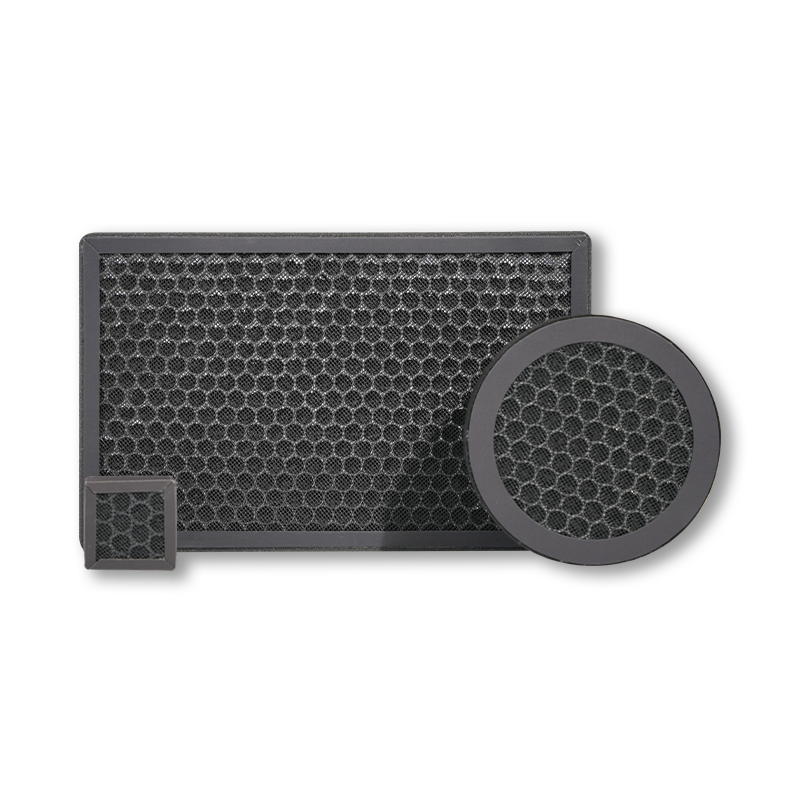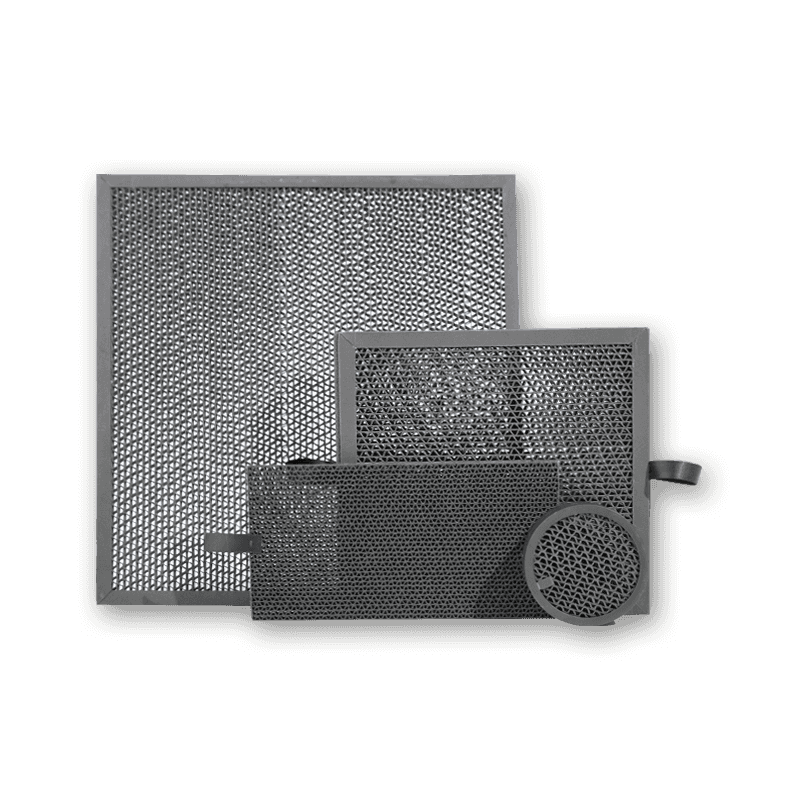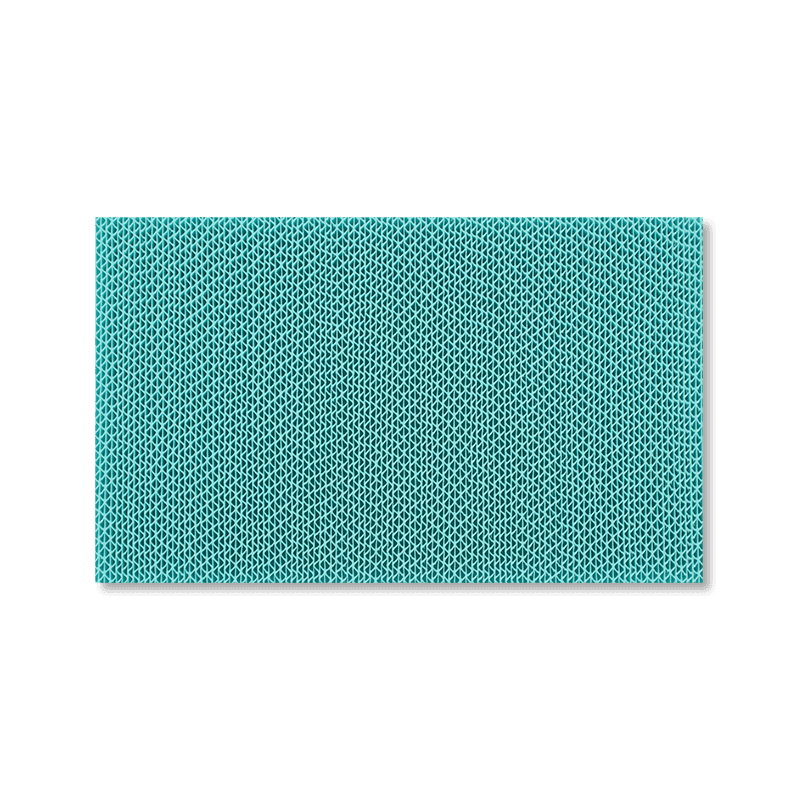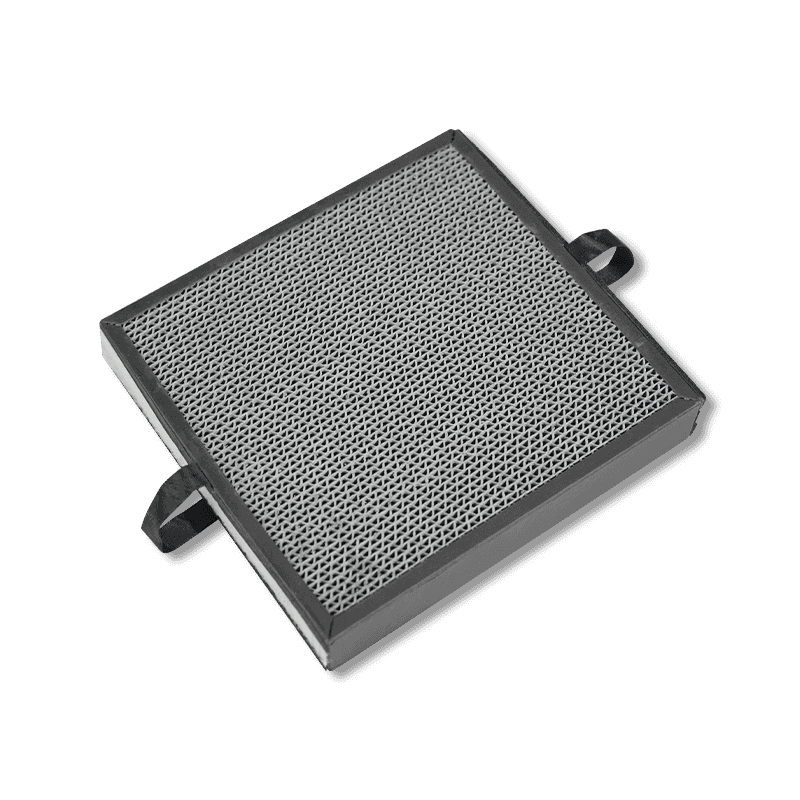Introduction: The growing demand for advanced air purification
A new era in air purification technology
With indoor air quality becoming a major health concern in today’s society, Photocatalyst filter mesh technology has emerged as a breakthrough solution. Unlike traditional methods, this innovative system not only filters the air, but also actively converts harmful pollutants into harmless substances through advanced photochemical reactions.
At the heart of this technology lies a remarkable process where light energy triggers a powerful purification reaction. When specially designed photocatalytic materials are exposed to UV light, they trigger a molecular-level transformation of pollutants in the air. This represents a major leap forward from passive filtration methods, providing continuous, chemical-free air purification.
Transformative Applications Across Industries
The versatility of photocatalyst technology enables innovative applications in different settings:
Smart Home Integration
Modern residential systems combine photocatalysis with smart sensors to create self-regulating air purification ecosystems. These systems automatically adjust purification intensity based on real-time air quality measurements to provide optimal protection while maximizing energy efficiency.
Healthcare Settings
Hospitals and clinics are adopting photocatalytic systems because of their ability to continuously neutralize airborne pathogens without producing harmful byproducts. The technology is particularly useful in environments such as operating rooms and isolation wards where air purity is critical.
Commercial and Industrial Solutions
From office buildings to manufacturing plants, large-scale photocatalytic systems provide effective air quality management. Capable of breaking down industrial fumes and chemical vapors, they are ideal for demanding environments where traditional filters would quickly saturate.
The Way Forward: Next-Generation Developments
Ongoing research is pushing the boundaries of photocatalytic technology:
Advanced nanomaterials with enhanced light absorption properties
Hybrid systems combining photocatalysis with other purification methods
Energy optimization to maximize efficiency under a variety of lighting conditions
Smart integration with building management systems to automate air quality control
These innovations promise to make photocatalytic air purification more accessible, efficient, and effective in all types of indoor environments.
Fresh Air for the Future
Photocatalyst filter technology represents a paradigm shift in the way we approach indoor air quality. The technology moves beyond mechanical filtration to active molecular transformation, providing a more sustainable, efficient, and easier-to-maintain solution for clean air. As the technology continues to advance, it promises to become the global standard for healthy indoor environments—creating a space that doesn’t just filter clean air, but revolutionizes air quality.
How Photocatalyst Filters Work: The Science Behind the Innovation
The Photocatalytic Process: Breakdown at the Molecular Level
The efficiency of a photocatalytic filter lies in its ability to use light energy to trigger a powerful chemical reaction that breaks down pollutants. Here is a step-by-step explanation of how it works at the molecular level:
Light Absorption and Electron Excitation
Photocatalysts, most commonly titanium dioxide (TiO₂), act like light-activated semiconductors. When exposed to UV or visible light, the light energy excites electrons in the TiO₂, causing them to jump from their normal state (valence band) to a higher energy level (conduction band). This creates free electron pairs (e⁻) and positively charged "hole pairs" (h⁺).
The free electrons are highly reactive and can participate in reduction reactions.
These holes act like electron scavengers, trying to pull electrons from nearby molecules to stabilize themselves.
Formation of Reactive Oxygen Species (ROS)
These free electrons and holes react with water vapor (H₂O) and oxygen (O₂) in the air to produce highly reactive molecules called reactive oxygen species (ROS), which include:
Hydroxy radicals (·OH):
Formed when positively charged holes pull electrons from water molecules.
These free radicals are among nature’s strongest oxidants, capable of breaking down stubborn pollutants.
Superoxide ions (O₂⁻):
Produced when free electrons attach to oxygen molecules.
They can further react to form hydrogen peroxide (H₂O₂), another powerful disinfectant.
Together, these ROS act as miniature “cleaners” that actively attack pollutants in the air.
How pollutants are eliminated
ROS attack pollutants through oxidation, breaking them down into harmless substances:
Organic pollutants (VOCs, bacteria, viruses, mold):
Hydroxy radicals break down carbon-based molecules, converting them into carbon dioxide (CO₂) and water (H₂O).
For example, formaldehyde, a common indoor air pollutant, is completely broken down into non-toxic carbon dioxide and water.
Inorganic pollutants (nitrogen oxides, sulfur oxides from smoke and exhaust gases):
They are oxidized into nitrates and sulfates, which are stable, non-toxic compounds that are easily removed.
Microorganisms (bacteria, viruses, mold spores):
ROS pierce cell walls and damage genetic material (DNA/RNA), effectively killing bacteria and inactivating viruses.
Why the process is so effective
Unlike conventional filters that simply capture pollutants, photocatalytic technology actively destroys pollutants at a molecular level. This means:
No harmful substances accumulate on the filter.
There is no risk of pollutants being released back into the air.
Purification continues as long as there is light.
This makes photocatalyst filters a self-cleaning, long-lasting and highly effective air purification solution.
Key advantages over traditional filtration methods
Unlike passive filters (HEPA, activated carbon), photocatalyst meshes actively destroy pollutants, offering several superior benefits:
Continuous air purification, unsaturated
Activated carbon adsorbs gases, but can re-release them when saturated.
Photocatalysis permanently breaks down pollutants, ensuring they are not re-emitted.
Self-cleaning and antimicrobial properties
The oxidation process prevents biofilm from forming on the filter surface.
Unlike HEPA filters, which can harbor mold and bacteria, TiO₂ meshes inhibit microbial growth, reduce odors and reduce maintenance.
Broad-spectrum pollutant removal
Where HEPA only captures particulate matter, photocatalysis effectively targets:
Chemical VOCs (formaldehyde, benzene, cigarette smoke)
Airborne pathogens (flu, SARS-CoV-2, mold spores)
Odors (from cooking, pets and industrial emissions)
Energy efficiency and longevity
Works in ambient light (although UV light can increase efficiency).
No consumable parts – no frequent replacements required.
Practical applications and future potential
Innovative integration of HVAC systems
Integration of HVAC systems with photocatalytic filtration technology is redefining indoor air quality standards in modern building environments:
Negative pressure ward system: HEPA filtration is used to increase the inactivation rate of viruses such as SARS-CoV-2 to 99.97%
Central air conditioning ducts: Built-in self-cleaning photocatalytic coating, reducing 90% biofilm accumulation
Commercial building building applications
Smart office system: Through the linkage of IoT sensors, when the carbon dioxide concentration exceeds 800ppm, the photocatalytic module automatically starts
High-rise building solution: Distributed photocatalytic purification devices are used to treat specific pollutants on each floor
Energy-saving performance: Compared with traditional purification methods, the overall energy consumption of the system is reduced by 35-40%
Technological innovation
New heat exchanger: The surface is coated with TiO2 that responds to visible light Coating
Air volume optimization: The wind speed is controlled at 2.5-3.5m/s for the best purification efficiency
Maintenance cycle: The service life of the filter is extended to 3 times that of the traditional system
Breakthrough in automobile air purification system
Modern automobile photocatalytic systems have developed multiple generations of technological innovations:
Key technical indicators
Start-up time: Reach the best working state within 30 seconds at room temperature
Applicable space: Standard compartment (3m³) can be completely purified in only 8-10 minutes
Power consumption control: Peak power does not exceed 15W, which does not affect the battery life of electric vehicles
Multi-function integrated system
Intelligent recognition module: Automatically identify and process through odor sensors:
Volatile substances (formaldehyde/benzene) of new cars
Residual odor of food
Pet odor
Cigarette smoke
Application in special environments
Electric vehicle battery pack: Prevent toxic gases generated by thermal runaway
Automatic driving mode: Gas long =In a closed state for a period of time
Shared cars: effectively solve cross-contamination between different users
Performance verification
Tunnel test: In an environment with PM2.5>300μg/m³, it drops below 35μg/m³ within 15 minutes
Extreme temperature: -30℃ to 85℃ for normal operation
Durability: efficiency decay <5% after 5000 hours of continuous operation
Innovative solutions for industrial waste gas treatment
Photocatalytic technology shows unique advantages in industrial pollution control:
Typical application scenarios
Chemical park:
Processing capacity: Maximum processing capacity of a single device is 50000m³/h
Complex component processing: can simultaneously degrade benzene, sulfide and nitrogen oxides
Operating cost: 60% lower than traditional RTO technology
Electronic manufacturing industry:
Special gas processing: effectively decompose corrosive gases such as HF and HCl
Clean room support: maintain 1000-level cleanliness
Heavy metal capture: gaseous mercury removal rate >95%
Technological innovation
Mobile treatment device: used for emergency treatment of sudden pollution incidents
Photovoltaic drive system: realize off-grid waste gas treatment
Intelligent monitoring platform: real-time display:
Pollutant degradation efficiency
Catalyst activity status
Energy consumption data
Economic benefits
Investment payback period: usually 18-24 months
Maintenance cost: 70% lower than activated carbon adsorption method
By-product value: some pollutants can be converted into usable chemicals
Practical application: significant advantages of photocatalyst filters
Living space: Creating a healthy and comfortable home environment
In modern home life, photocatalytic filtration technology is bringing new solutions to home air purification:
Allergen control
For pollen allergies: Photocatalytic reactions can effectively decompose the allergenic proteins on the surface of pollen particles, making them lose their allergenicity. Experimental data show that after using a photocatalytic air purifier during the pollen season, the reduction rate of allergic symptoms can reach 73%.
For pet allergies: It can not only decompose pet dander floating in the air, but also continuously decompose allergenic proteins attached to pet hair
Dust mite control: It can decompose Der p1 allergens in dust mite excrement to reduce allergic reactions at the source
Deodorization system
Kitchen fume control: For the high-concentration fume produced by Chinese cooking, photocatalytic technology can reduce PM2.5 concentration by more than 90% within 30 minutes, and completely decompose carcinogens such as benzopyrene in the fume
Bathroom deodorization: It can not only eliminate odor molecules such as ammonia, but also kill more than 80% of E. coli in the air
New pollution from decoration: The formaldehyde decomposition efficiency is as high as 98%, and no secondary pollution will be generated
Smart home integration
Linked with air conditioning system: It can be embedded in the central air conditioning system to achieve whole-house air purification
Energy consumption performance: In a standard bedroom environment, the average daily power consumption is only 0.5 degrees
Maintenance cost: Compared with traditional HEPA filters, it can save about 2,000 yuan in replacement costs within 5 years
Office space: air quality solutions to improve work efficiency
Modern office environments face special air challenges:
Targeted treatment of pollutants
Electronic equipment emissions: Effectively decompose ozone and toner particles released by laser printers
Decoration pollution: TVOC removal rate of new offices can reach 95%/24h
Human metabolites: Can decompose metabolites such as carbon dioxide to keep the air fresh
Economic benefit analysis
Employee efficiency: Improving air quality can increase work efficiency by 15-20%
Reducing sick leave: Each person can save 3-5 days of sick leave costs per year
Equipment maintenance: The cleaning frequency of the central air conditioning system is reduced by 50%
Application in special places
Data center: prevent server corrosion and extend equipment life by 30%
Laboratory: effectively control volatile chemical reagents
Conference room: shorten air recovery time after meeting to 1/3 of traditional methods
Industrial field: professional-grade air pollution control solution
In industrial production, photocatalytic technology has demonstrated strong pollution control capabilities:
Manufacturing application
Automobile spraying: VOCs removal efficiency reaches 98.5%, much higher than traditional activated carbon adsorption
Electronic factory: can control molecular-level pollution in clean rooms
Pharmaceutical workshop: meet the air quality requirements of GMP certification
Innovation in the transportation field New
Metro system: can still maintain more than 80% purification efficiency during peak hours
Aviation application: aircraft cabin air circulation purification system
Ship cabin: solve the problem of air quality in confined space
Emerging fields: open up application prospects
Photocatalytic technology shows unique advantages in some emerging fields:
Modern agricultural applications
Greenhouse planting: can increase crop yields by 12-15%
Livestock and poultry farming: reduce ammonia concentration and reduce the occurrence of respiratory diseases
Cold chain logistics: extend the shelf life of fruits and vegetables by 3-5 days
Food processing innovation
Baking workshop: control the risk of flour dust explosion
Winemaking environment: keep Maintain air purity
Catering kitchen: achieve ultra-low emission of oil smoke
Technical advantages and future prospects
Photocatalytic filtration technology has significant advantages over traditional purification solutions:
Continuous purification capacity: 7×24 hours uninterrupted work, purification efficiency attenuation rate <5%/year
Broad-spectrum purification effect: can simultaneously treat more than 300 known air pollutants
Energy-saving and environmental protection characteristics: unit purification energy consumption is only 1/3 of traditional technology
Future development trends:
Deep integration with Internet of Things technology
Research and development of new photocatalytic materials (such as graphene composite catalysts)
Application in outdoor air pollution control
Development of self-cleaning building surfaces
Challenges and future innovations
As air pollution becomes increasingly serious, photocatalytic filters, as an efficient and environmentally friendly air purification technology, are increasingly widely used in indoor air purifiers, public environmental governance, and industrial waste gas treatment. Photocatalysts (usually represented by titanium dioxide TiO₂) rely on light energy to excite electron-hole pairs, thereby achieving the decomposition and degradation of harmful gases, organic pollutants, and microorganisms in the air. Although photocatalytic technology has the advantages of no secondary pollution and mild reaction conditions, it still faces some challenges to achieve large-scale promotion.
Existing Challenges
Light dependence
Traditional titanium dioxide photocatalysts can only work effectively under the stimulation of ultraviolet light, but ultraviolet light only accounts for about 4% in the natural environment, and most visible light cannot stimulate photocatalytic reactions. This means that the efficiency of photocatalytic filters will drop significantly in low light or even at night. Although there have been attempts to develop visible light responsive photocatalysts (for example, by doping metal ions or non-metallic elements), their efficiency and stability still need to be further optimized.
Durability issues
Photocatalysts exposed to complex air environments for a long time may face problems such as surface contamination and deactivation. For example, organic matter in the air will form an adsorption film on the surface of the catalyst, reducing its light absorption efficiency. As the use time increases, the catalyst activity will gradually decrease, which poses a challenge to the service life and economy of the filter.
Future Innovation Directions
Nano-enhanced photocatalysts
Nanotechnology has brought unprecedented performance improvements to photocatalysts. Nanoscale TiO₂ particles not only have a huge specific surface area, which can provide more reaction sites, but also have significantly improved optical and electrical properties due to quantum size effects. Researchers are exploring the following types of nanocomposite photocatalysts:
Graphene-TiO₂ composite materials: The high conductivity of graphene can significantly accelerate the migration of photogenerated electrons and reduce electron-hole recombination, thereby improving catalytic efficiency. The two-dimensional structure of graphene can also provide a larger contact surface for TiO₂, greatly improving the reaction rate.
Plasmonic nanoparticles: By loading metal nanoparticles such as gold and silver on the surface of TiO₂, the localized surface plasmon resonance effect (LSPR) is used to convert visible light into hot electrons, thereby exciting TiO₂. This method can expand the light response range from the ultraviolet region to the visible light region, thereby improving the efficiency under low-light conditions indoors.
Multifunctional nanocomposites: Some new studies combine titanium dioxide with silver ions, zinc oxide or copper-based materials, which not only have strong redox capabilities, but can also directly destroy bacterial cell membranes or inhibit viral activity. This type of multifunctional material can not only purify toxic gases in the air, but also sterilize and disinfect, especially suitable for crowded places such as hospitals and subways.
Future nanophotocatalysts may be customized by precisely controlling structural parameters such as particle size, morphology, and surface defects to meet the needs of air purification in different environments.
New visible light responsive materials
In order to get rid of the dependence on ultraviolet light, the development of visible light responsive photocatalysts has become a research hotspot. In addition to doping and modifying TiO₂, researchers are also studying a series of new semiconductor materials:
Narrow bandgap semiconductors: such as tungsten oxide (WO₃), cadmium sulfide (CdS), bismuth oxide (Bi₂O₃), etc. This type of material can absorb more visible light, but the problem of photocorrosion or insufficient stability needs to be solved.
Perovskite materials: Organic-inorganic hybrid perovskite materials have attracted much attention due to their high light absorption efficiency and adjustable band structure. They have outstanding performance in the photovoltaic field and are expected to be used for photocatalytic air purification in the future.
Carbon nitrogen compounds (g-C₃N₄): This type of non-metallic photocatalyst has good visible light response ability and chemical stability. It is currently often combined with TiO₂ to form a heterojunction structure to enhance the carrier separation efficiency.
Through reasonable material design and surface engineering, visible light responsive photocatalysts in the future can not only utilize daily lighting sources, but also achieve all-weather, low-energy, and efficient air purification.
Integration of intelligence and the Internet of Things (IoT)
The future photocatalytic filter is not only a "passive" purifier, but also an intelligent air quality management system:
Real-time monitoring feedback: built-in sensors can detect PM2.5, formaldehyde, CO₂, and VOCs concentrations in real time, and feed back data to mobile phone APP or smart home platform.
Automatic light source control: Automatically adjust the intensity and wavelength of LED lights according to air quality to ensure that the catalyst operates under optimal excitation conditions.
Data prediction and cloud computing: By connecting meteorological data and external air monitoring systems, smart filters can predict air pollution trends in advance and actively start purification programs.
Fault diagnosis and life management: The IoT system can evaluate the performance degradation of the catalyst and promptly remind users when cleaning or replacement is needed.
This intelligent upgrade can not only improve the efficiency and energy saving of air purification, but also provide users with more personalized air management services.
Modular and multifunctional design
In the future, Photocatalyst filter mesh will develop in a multifunctional direction:
Multi-layer composite purification: Combine photocatalyst filters with HEPA, activated carbon or electrostatic dust removal modules to achieve all-round purification of particulate matter, odor and bacteria.
Modular replacement: Users can replace modules with different functions at any time, such as "antibacterial module" and "formaldehyde removal module", just like changing ink cartridges, which greatly improves the flexibility of use.
Multi-environment adaptability: In the future, filters can automatically adjust humidity and wind speed according to environmental conditions. For example, in the dry season, it can be combined with humidification function to automatically inhibit mold growth in a humid environment.
This highly integrated and personalized design is expected to become an important trend in smart home appliances in the future.
Green manufacturing and recycling
With the increase of environmental awareness, photocatalytic filters will also pursue a lower carbon footprint in the manufacturing process:
Green synthesis process: Use low-temperature sol-gel method, hydrothermal synthesis, ultrasonic-assisted and other energy-saving methods to prepare photocatalysts and reduce chemical waste liquid emissions.
Recyclable materials: Research and develop recyclable or biodegradable filter materials, such as cellulose, PLA and other degradable polymers.
Regeneration technology: Through simple illumination or low-temperature calcination, the surface activity of the catalyst can be "restored", thereby achieving multiple recycling, extending its life and reducing costs.
This green manufacturing concept will further promote the sustainable development of photocatalytic filters.
A cleaner, smarter future for indoor air
Transition from passive purification to active purification
Photocatalysts are mainly used to remove TVOC, and have a stronger direct comparison with activated carbon. HEPA is a high-efficiency filter made of high-efficiency filter paper (used to efficiently remove PM2.5, pollen and other small particles), which is not very comparable to photocatalysts. Small particles that HEPA can remove may not be removed by photocatalysts with different substrates.
Traditional air purifiers mostly use HEPA filters, activated carbon or electrostatic dust collection modules. Although these methods can effectively capture particulate matter and some harmful gases, there are often two problems:
Secondary pollution risk: activated carbon will release adsorbed pollutants after saturation; HEPA filters need to be replaced frequently, otherwise they will become a breeding ground for bacteria and mold.
Limited processing capacity: For gaseous pollutants such as volatile organic compounds (VOCs) and formaldehyde, these passive filter materials are difficult to completely decompose, and can only temporarily "lock" the pollution source by adsorption.
The emergence of photocatalytic technology is an innovation aimed at the above problems. Photocatalysts such as TiO₂ produce strong oxidizing power under light, which can completely decompose organic pollutants such as formaldehyde, benzene, and toluene into CO₂ and H₂O without causing secondary pollution. This "active purification" feature makes the photocatalytic filter no longer just an "air filter", but an "air repair system", which fundamentally improves the quality of air purification.
Deep integration of smart home and photocatalysis
With the rapid development of the concept of smart home, the future air purification system will no longer be just an independent device, but a part of the home ecosystem. With the popularization of the Internet of Things (IoT), sensor technology and artificial intelligence (AI), photocatalyst filters can be seamlessly connected with smart home appliances and environmental monitoring systems to achieve "automatic, visual and personalized" air management.
Automatic control
Intelligent photocatalytic purification equipment can automatically adjust the light source intensity, fan power and operation mode according to the real-time monitored air quality. For example, when the sensor detects an increase in PM2.5 or VOC concentration, the system can automatically start the high-efficiency photocatalytic mode to quickly reduce the indoor pollution level.
Data visualization
The future intelligent purification system can present indoor air quality data in the form of intuitive charts through mobile phone APP or intelligent central control platform. Users can view historical trends, current pollutant concentrations at any time, and obtain corresponding health advice. This data management makes the air purification process quantifiable and traceable.
Personalized scene linkage
The photocatalyst filter can be linked with other smart devices in the home. For example, when the air quality decreases, the air conditioner will automatically adjust the ventilation mode, and the smart curtains will automatically close to prevent external pollutants from entering; at the same time, the purifier will enter the high-efficiency mode to ensure that the air quality returns to a healthy level.
This intelligent and scene-based linkage indicates that air purification in the future will no longer be an isolated device behavior, but will be integrated into the overall home ecology.
Application prospects in commercial buildings and public spaces
In addition to the home environment, photocatalyst filtration technology also has great potential in public places such as commercial buildings, offices, hotels, schools, and hospitals. In recent years, "sick building syndrome" (SBS) has been frequently mentioned. Many modern buildings are highly airtight and poorly ventilated, resulting in the accumulation of indoor pollutants, causing dizziness, allergies, and even respiratory diseases.
Photocatalytic filters have the following advantages in these scenarios:
Strong sustainability: Unlike traditional filter materials that need to be replaced frequently, photocatalysts can remain active for a long time under appropriate light and only need to be cleaned regularly.
Sterilization and disinfection ability: Photocatalysts can effectively kill bacteria, viruses, and mold in the air, and are very suitable for use in hospitals, clinics and other places.
Low maintenance cost: Photocatalyst filters do not require a large amount of consumables during long-term use, and are more suitable for large-scale air purification in commercial spaces.
In the future, with the popularization of building intelligence and green building concepts, photocatalytic air purification systems may be directly integrated into central air-conditioning systems to achieve unified air management for the entire building.
Driven by health awareness
In the past few years, global attention to indoor air quality has risen sharply, especially after the epidemic, people are more concerned about the relationship between air transmission pathways and health. Studies have shown that long-term exposure to polluted indoor air increases the risk of asthma, allergies and even cardiovascular disease. For children, the elderly and people with low immunity, clean air is not only a necessity for a comfortable life, but also an important factor in ensuring health.
The application of photocatalyst technology is not limited to the removal of visible pollutants, but can also effectively degrade trace harmful gases such as formaldehyde, benzene, and TVOC, which are difficult to completely solve by traditional purification methods. As the public has a deeper understanding of the relationship between air quality and health, photocatalytic purification equipment is expected to become the "standard configuration" of homes and public places in the future.
Technological innovation drives cost reduction and popularization
Although photocatalytic filters have shown great potential in technology, their high cost has always been the main factor hindering their popularization in the past. With the maturity of nanomaterial preparation technology and the improvement of mass production capacity, the price of TiO₂ and its composite materials has gradually declined. At the same time, the new generation of LED light sources has low energy consumption and long life, which further reduces the overall operating cost of the photocatalytic system.
Manufacturers are exploring more efficient photocatalytic reaction structure designs, such as increasing the contact area between the catalyst and the air through three-dimensional porous networks or fiber membrane technology, thereby achieving higher purification efficiency with a smaller volume. This technological innovation and cost optimization will make it easier for photocatalytic purification equipment to enter the mass household market.
Future prospects of photocatalytic purification
In the next 5 to 10 years, photocatalytic air purification may show the following development trends:
Whole-house integration: no longer need a separate purifier, but integrate the photocatalytic system with air conditioning, ventilation ducts, and smart home control platforms to achieve unified management.
AI self-learning optimization: AI algorithms can automatically learn the best purification strategy based on user habits and air quality data to achieve a balance between high efficiency and energy saving.
Modular upgrade: Users can add specific modules according to their needs, such as high-efficiency pollen removal modules for allergy seasons, odor purification modules for pet families, etc.
Cross-domain applications: In the future, photocatalytic technology may expand to areas such as automotive air conditioning systems and portable personal purification devices, allowing people to enjoy clean air at home, in the office, or on the go.

 English
English Español
Español 日本語
日本語











